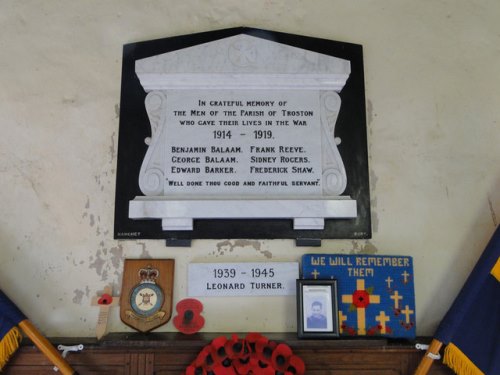- Screen Colours:
- Normal
- Black & Yellow

The Church has two plaques, but little information on the young men of the Parish who gave their lives in the First and Second World Wars. We have discovered from conversations with relatives who still live in the village some information which is detailed below.
Benjamin (Ben) Balaam. Aged 21, youngest son of Harry and Sarah Balaam who lived along Common lane. He worked as a farm labourer before joining the Duke of Cambridge’s Own (Middlesex) Regiment.
Killed 28th October 1916 during the assault on the strong points in front of Le Transloy, known as Rainy Trench, and Dewdrop Trench.
According to the Regimental Diary: “after an intense artillery barrage, at 6am the Regiment went over the top and were met by much machine gun and rifle fire from the flanks - but the attack was pushed forward, and the first objective Rainy Trench gained. After fierce hand to hand fighting for Dew Drop Trench, by 9.30 am the whole objective was in our hands. The enemy did not attempt to counter attack but enemy snipers were active against our wounded stranded in No Mans Land.”
George Balaam. Aged 24,eldest son of Harry and Sarah Balaam. Worked as a farm labourer before joining up with his brother.
Killed in action, Flanders 9th August 1917.
Edward Barker. Aged 18, youngest son of George and Sarah Barker who lived near the end of Common Lane. He worked as a farm labourer and also joined the Duke of Cambridge’s Own (Middlesex) Regiment.
Killed 22nd August 1918 while reconnoitring a forward post in Wippenhoek, near Ypres in Belgium.
Cyril Arthur Blizzard. Aged 26, the middle son of Arthur and Edith Blizzard who lived in a cottage on Common Lane. He was apprenticed to his father who was a shoemaker.
Joined the Army in February 1916 and caught Tuberculosis in the right lung while in training in Yorkshire that year. (Tuberculosis is a bacterial infection spread through inhaling tiny droplets from the coughs or sneezes of an infected person. Today, with modern antibiotics, a serious condition, that can usually be cured.) Alas, in 1916 these drugs were not available and the disease spread to affect his glands, bones and nervous system.
After three desperate years in an isolation hospital he was discharged from the Army as unfit in January 1919 - and died 9 months later.
Frank Alfred Reeve. Aged 24, one of 11 children of Robert and Rebecca Reeve who ran the Post Office and Grocery Shop in what is now Glebe Cottage. Frank was the village postman.
Mown down by machine gun fire during the opening of the battle of the Somme 9 Aug 1916 - but family only knew he was missing in action, perhaps a prisoner, until the fateful telegram the following year.
Sidney Thomas Rogers. Aged 19, youngest son of John and Jane Rogers who lived in Old Farm, Little Livermere. He was a farm labourer. Believed killed during the final battle of the Somme - 4th April or 29th September 1918.
Frederick Charles Shaw. Aged 22, youngest son of Alexander and Harriet Shaw who lived in The Street, near the school house. Died of his wounds in the trenches around La Boiselle and Fricourt during the battle of the Somme, 22nd August 1916.
The first Battle of the Somme took place between 1 July and 18 November 1916 on the upper reaches of the River Somme in France. The battle was intended to hasten a victory for the Allies and was the largest battle of the First World War on the Western Front. More than one million men were wounded or killed, making it one of the bloodiest battles in human history - to gain 6 miles on a 16 mile front.
Leonard Turner: Youngest of nine children and lived in a cottage where 13 Church Cottage now stands.
“He joined the Navy and was posted to Lowestoff on minesweeping duties. A dangerous role and I can remember the family lived in foreboding every time he set sail. Alas, shortly after D-Day the dreaded telegram arrived. I was sent to fetch my grandfather who was driving the horses in the nearby fields. My grandmother was devastated and never recovered from her grief”.
His ship, H.M. Gairsay, was sunk during the night of 3rd August, 1944 by a one-man submarine off the coast of Normandy. He was just 22. These German submarines were one of Hitler's "secret weapons" to stem the liberation of Europe and either carried a torpedo or a cluster of remotely controlled midget motor-boats with an explosive charge in the bow. Their only foray was the fateful night of the 3rd August, when they sunk the destroyer "Quorn", two transport ships, a landing craft - and, near the end of the engagement, the mine-sweeper "Gairsay".
Apparently it was largely through the efforts of the crew of the Gairsay, which carried a light machine-gun which could traverse low enough, fifty eight of the motor-boats and all the submarines were destroyed that night, before they inflicted more damage on the Allied ships.
A sad end to a brave young man - he and the other young men deserve to be remembered.
From Doreen Newell